The Ultimate Guide to the Biewer Terrier
Introduction to the Biewer Terrier
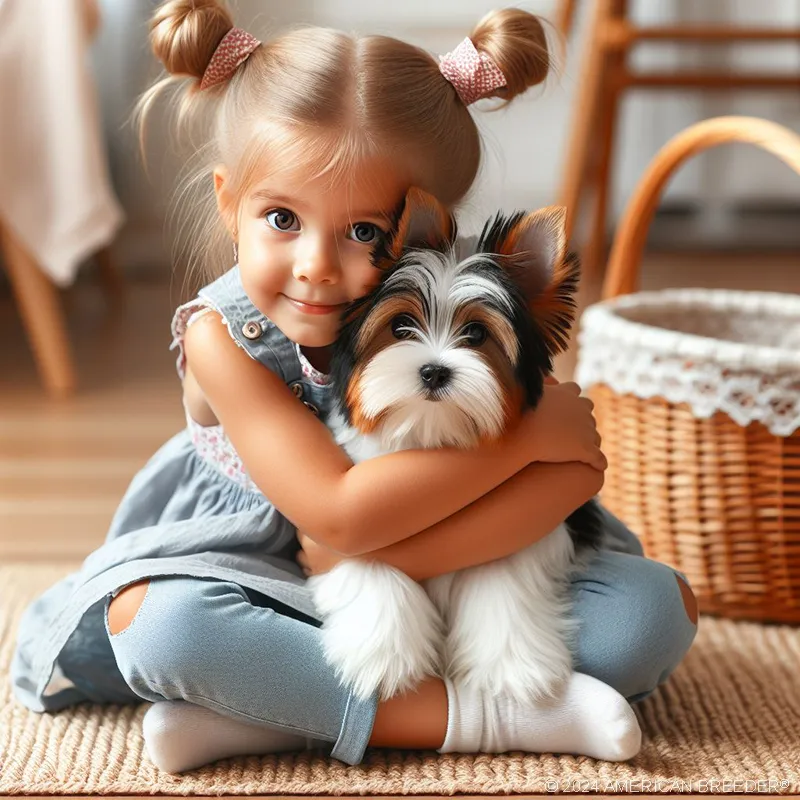 The Biewer Terrier is a distinctive and charming breed known for its unique appearance and delightful personality. Originating from Germany, this small but lively terrier is a variation of the Yorkshire Terrier, bred for its unique color pattern and cheerful disposition. The Biewer Terrier has rapidly gained popularity due to its engaging nature and elegant look, making it a favorite among dog enthusiasts.
The Biewer Terrier is a distinctive and charming breed known for its unique appearance and delightful personality. Originating from Germany, this small but lively terrier is a variation of the Yorkshire Terrier, bred for its unique color pattern and cheerful disposition. The Biewer Terrier has rapidly gained popularity due to its engaging nature and elegant look, making it a favorite among dog enthusiasts.
History and Origins
The Biewer Terrier’s story begins in the early 1980s in Germany, where it was developed by Werner and Gertrude Biewer. This breed was initially bred as a color variation of the Yorkshire Terrier, with the Biewers striving to create a dog that featured a distinctive tricolored coat. Their goal was to maintain the Yorkshire Terrier’s charming personality while introducing a new palette of colors, including blue, white, and gold. The breed gained recognition through its unique appearance and by the late 1980s, it had established itself as a distinct breed. The Biewer Terrier made its way to the United States in the early 2000s and has since been embraced by dog lovers around the world.
Physical Characteristics
The Biewer Terrier is a small breed with a refined and elegant appearance. Typically weighing between four to eight pounds, this dog is characterized by its long, silky coat that is usually a combination of blue, white, and gold. The Biewer’s coat requires regular grooming to maintain its luster and prevent tangles. Its head is adorned with a distinctive topknot, often tied up with a ribbon, which adds to its refined look. The breed has a well-proportioned body with a straight back and a tail that is carried high and gracefully. Their eyes are dark and expressive, contributing to their overall lively and engaging expression.
Temperament and Personality
The Biewer Terrier is renowned for its vibrant and affectionate personality. This breed is energetic and playful, thriving on interaction and companionship. Despite its small size, the Biewer Terrier has a bold and confident demeanor, often displaying a spirited attitude that belies its stature. It is a highly intelligent breed, which can make training both enjoyable and rewarding, though consistent and positive reinforcement methods work best. Social by nature, the Biewer Terrier gets along well with children and other pets, making it an excellent choice for families and multi-pet households. Its loving nature and strong bond with its owner make it a delightful companion.
Care and Grooming
Proper care and grooming are essential to maintaining the Biewer Terrier’s health and appearance. This breed’s long coat requires regular brushing to prevent mats and tangles. Daily grooming is ideal, though at a minimum, a few times a week is necessary. Bathing should be done as needed to keep the coat clean and shiny, using a mild dog shampoo to avoid skin irritation. The Biewer Terrier’s eyes and ears should be checked regularly for signs of infection, and dental hygiene should be maintained through regular brushing and check-ups. Additionally, routine vet visits will help ensure that the dog remains in optimal health.
Exercise and Training
The Biewer Terrier is an active and agile breed that benefits from regular exercise to stay healthy and happy. Although its small size means that its exercise needs are relatively modest, daily walks and playtime are important to keep it physically stimulated and mentally engaged. This breed enjoys interactive games and activities that challenge its intelligence and agility. Training the Biewer Terrier is generally a positive experience due to its intelligence and eagerness to please. Consistency and patience are key, as this breed responds best to positive reinforcement techniques. Early socialization and basic obedience training are recommended to help the Biewer Terrier develop into a well-adjusted adult dog.
Health Considerations
 The Biewer Terrier is generally a healthy breed, but like all dogs, it can be prone to certain health issues. Potential health concerns include dental problems, patellar luxation, and certain genetic conditions that can affect the coat or skin. Regular veterinary check-ups and a balanced diet are crucial in preventing and managing these issues. Responsible breeding practices can also help reduce the risk of hereditary health problems. It is important for prospective owners to choose a reputable breeder who performs health screenings to ensure the wellbeing of the puppies.
The Biewer Terrier is generally a healthy breed, but like all dogs, it can be prone to certain health issues. Potential health concerns include dental problems, patellar luxation, and certain genetic conditions that can affect the coat or skin. Regular veterinary check-ups and a balanced diet are crucial in preventing and managing these issues. Responsible breeding practices can also help reduce the risk of hereditary health problems. It is important for prospective owners to choose a reputable breeder who performs health screenings to ensure the wellbeing of the puppies.
Living with a Biewer Terrier
Living with a Biewer Terrier can be a highly rewarding experience due to its affectionate nature and lively personality. This breed adapts well to various living environments, whether it be an apartment or a house with a yard. Its small size makes it suitable for urban living, though it still requires regular exercise and mental stimulation. The Biewer Terrier’s playful and sociable demeanor means it thrives on attention and enjoys being part of family activities. Its adaptable nature and charming personality make it a wonderful companion for individuals, couples, and families alike.
Introduction and Breed Background
The Enchanting Biewer Terrier is a Dazzling Blend of Elegance and Playfulness
The Biewer Terrier, a relatively new and charming breed, captivates with its distinctive appearance and vibrant personality. Known for its long, silky coat and elegant demeanor, this small dog typically weighs between four to eight pounds. Its coat showcases a beautiful combination of blue, white, and gold, which sets it apart from other terriers. Despite its dainty size, the Biewer Terrier is lively and spirited, with a personality that combines confidence, playfulness, and affection. It is a breed that thrives on human companionship, making it an ideal choice for those seeking a devoted and interactive canine companion.
Considerations Before Choosing the Biewer Terrier
Before deciding to bring a Biewer Terrier into your home, it is essential to consider several factors. First and foremost, potential owners should be prepared for the breed’s grooming needs, as its long coat requires regular maintenance to keep it in good condition. Additionally, while the Biewer Terrier is generally adaptable to various living environments, it thrives best in a setting where it receives ample attention and interaction. Prospective owners should also consider their ability to meet the breed’s exercise requirements, which, although moderate, are essential for maintaining the Biewer Terrier’s health and happiness. Understanding the breed’s personality traits and potential health issues is crucial to ensure that it fits well with your lifestyle and living situation.
 Fascinating Insights and Fun Tidbits About the Biewer Terrier
Fascinating Insights and Fun Tidbits About the Biewer Terrier
The Biewer Terrier, while not as widely known as some other breeds, has several intriguing and enjoyable aspects. One notable fact is that the Biewer Terrier’s unique coat colors and patterns are a result of selective breeding efforts by the Biewer family, who sought to create a new color variation of the Yorkshire Terrier. Another fun fact is that despite their small size, Biewer Terriers are known for their spirited and bold personalities, often displaying a level of confidence that belies their stature. The breed's playful nature makes it a hit in agility sports and other canine activities.
Other Names for the Biewer Terrier
The Biewer Terrier is also known by several other names. In some circles, it is referred to as the “Biewer Yorkshire Terrier,” reflecting its origins as a variation of the Yorkshire Terrier. Additionally, it may be simply called the “Biewer,” which is often used colloquially among enthusiasts and breeders.
Nicknames for the Biewer Terrier
Affectionate nicknames for the Biewer Terrier often reflect its charming and playful nature. Common nicknames include “Biewer,” which highlights its unique breed identity, and “Biewie,” a playful and endearing term used by many of its admirers. These nicknames capture the breed’s friendly and approachable demeanor, making it even more beloved by those who know it.
Breed Background and History
Origin and Development of the Biewer Terrier
The Biewer Terrier’s origins trace back to the early 1980s in Germany, where it was developed by Werner and Gertrude Biewer. The breed emerged as a color variation of the Yorkshire Terrier, with a focus on producing a dog with a distinctive tricolor coat. The Biewers aimed to create a dog that not only retained the Yorkshire Terrier's personality but also showcased a unique and striking appearance. Their selective breeding efforts led to the establishment of the Biewer Terrier as a distinct breed, recognized for its unique coat colors and patterns.
Historical Significance or Cultural Relevance
The Biewer Terrier holds a special place in canine history due to its origins and the innovation brought by the Biewer family. It represents a significant development in the evolution of the Yorkshire Terrier, reflecting the desire to introduce new and distinctive traits while preserving the breed’s beloved characteristics. This breed’s creation highlights the role of dedicated breeders in shaping the canine world and expanding the diversity of dog breeds.
Purpose or Original Use of the Biewer Terrier
Originally, the Biewer Terrier was bred primarily as a companion dog, with no specific working purpose beyond being a delightful and affectionate pet. Its creation was driven by a desire to produce a visually distinct and charming variation of the Yorkshire Terrier, rather than for any utilitarian function. Today, the Biewer Terrier continues to serve as a devoted companion, cherished for its lively personality and elegant appearance.
 Kennel Clubs that Classify, Group, or Register the Biewer Terrier
Kennel Clubs that Classify, Group, or Register the Biewer Terrier
The Biewer Terrier is recognized by several kennel clubs and organizations worldwide. In the United States, it is registered with the American Kennel Club (AKC) under the Miscellaneous Group, as it is still in the process of gaining full breed recognition. Additionally, the Biewer Terrier is acknowledged by the United Kennel Club (UKC) and other international breed organizations, which classify and promote the breed according to its unique traits and characteristics.
Dog Characteristics
Size, Weight, Activity Level, and Physical Appearance
The Biewer Terrier is a small breed, typically weighing between four to eight pounds. It has a compact and well-proportioned body that exudes elegance and grace. Despite its diminutive size, the Biewer Terrier is energetic and active, enjoying regular play and interaction. Its physical appearance is marked by a long, flowing coat that requires regular grooming to maintain its quality. The breed’s refined features and stylish look make it stand out among small terriers.
Coat Type, Color Variations, and Patterns
The Biewer Terrier is renowned for its distinctive coat, which is one of its most defining features. Its coat is long, silky, and straight, and it comes in a unique tricolor pattern that typically includes blue, white, and gold. This coat color combination is the result of selective breeding aimed at producing a visually striking appearance. Regular grooming is essential to keep the coat tangle-free and shiny, and it plays a significant role in the breed’s overall presentation.
Distinctive Features or Markings
One of the Biewer Terrier’s most distinctive features is its coat, which is characterized by its long length and silky texture. The breed’s tricolor pattern, with its mix of blue, white, and gold, is a hallmark of its appearance. Additionally, the Biewer Terrier often sports a topknot, which is a tuft of hair on its head that can be styled with a ribbon, adding to its elegant look. These distinctive features contribute to the breed’s unique and appealing appearance.
Average Litter Size for the Biewer Terrier
The average litter size for the Biewer Terrier typically ranges from three to five puppies. This size is consistent with the breed’s small stature and reproductive characteristics. Litter sizes can vary based on factors such as the age and health of the dam, as well as the specific breeding practices employed.
Temperament and Personality
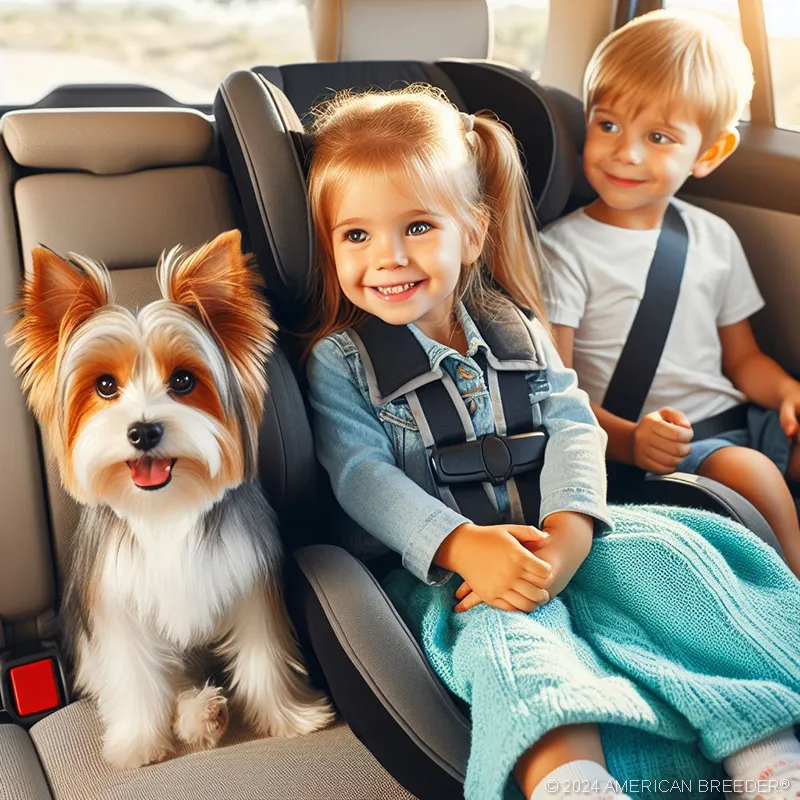 Typical Temperament Traits and Behavior Tendencies
Typical Temperament Traits and Behavior Tendencies
The Biewer Terrier is known for its lively and affectionate temperament. It is a cheerful and playful dog that enjoys interacting with its human companions. Despite its small size, the Biewer Terrier exhibits a bold and confident personality. It is often described as intelligent and alert, with a strong desire to engage in activities and play. This breed is also known for its loyalty and devotion to its family, making it a delightful companion.
Energy Levels and Activity Requirements
The Biewer Terrier is an energetic breed with moderate activity needs. It enjoys daily play and short walks, which are essential for keeping it physically and mentally stimulated. Although it is small in size, the Biewer Terrier has a lively disposition and benefits from regular exercise to maintain its overall health and happiness. Engaging in interactive play and activities helps satisfy its energetic nature.
Compatibility with Different Lifestyles and Family Dynamics
The Biewer Terrier is a versatile breed that adapts well to various living situations. Its small size makes it suitable for apartment living, provided it receives adequate exercise and mental stimulation. It is a good fit for families, singles, and seniors alike, thanks to its friendly and affectionate nature. The Biewer Terrier gets along well with children and other pets, making it a great addition to a variety of household dynamics.
List of Typical Behavior Issues
Aggression and Biting: The Biewer Terrier is generally not aggressive but can exhibit protective behavior if it feels threatened. Early socialization and training can help mitigate any aggressive tendencies.
Excessive Barking: This breed is known for being vocal, and excessive barking can occur if the dog is bored or not properly stimulated. Regular exercise and engagement can help manage barking issues.
Digging Behavior: Digging is not a common issue for the Biewer Terrier but may occur if the dog is left alone without sufficient stimulation. Providing toys and activities can help reduce this behavior.
Separation Anxiety: Biewer Terriers can develop separation anxiety if left alone for extended periods. Gradual desensitization and providing comfort items can help alleviate this issue.
Resource Guarding: Resource guarding is not prevalent in Biewer Terriers but can be addressed through proper training and socialization practices.
Fear and Phobias: Some Biewer Terriers may develop fears or phobias, such as fear of loud noises. Positive reinforcement and gradual exposure can help manage these fears.
Understanding Your Dog's Nature
Intelligence and Problem-Solving Abilities
The Biewer Terrier is an intelligent breed with strong problem-solving abilities. It quickly learns new commands and can excel in various training activities. Its intelligence makes it responsive to training and eager to participate in interactive games.
Trainability Level and Ease of Learning
The Biewer Terrier is generally easy to train due to its intelligence and eagerness to please. Positive reinforcement methods work best, as this breed responds well to rewards and praise. Consistent training sessions and clear communication help ensure successful learning.
Willingness to Please Their Owner
The Biewer Terrier is known for its desire to please its owner. This trait makes training and interaction enjoyable, as the dog is motivated by attention and affection. Building a strong bond with the Biewer Terrier enhances its responsiveness to training.
Recommended Training Approaches and Techniques
For the Biewer Terrier, positive reinforcement is the most effective training approach. Techniques that involve treats, praise, and encouragement help foster a positive learning environment. Consistency in training and clear, simple commands ensure that the Biewer Terrier remains engaged and motivated.
Differentiating Between Breed-Specific Traits and Individual Personality
While the Biewer Terrier has breed-specific traits such as its lively and affectionate nature, individual personalities can vary. Each dog may have unique preferences and quirks, influenced by its environment, socialization, and training experiences. Understanding and accommodating these individual differences are key to successful training and harmonious living.
Basic Training Fundamentals
Importance of Consistency and Positive Reinforcement
Consistency and positive reinforcement are crucial in training the Biewer Terrier. Using a consistent approach helps the dog understand expectations and respond appropriately. Positive reinforcement, such as treats and praise, motivates the dog and reinforces desired behaviors.
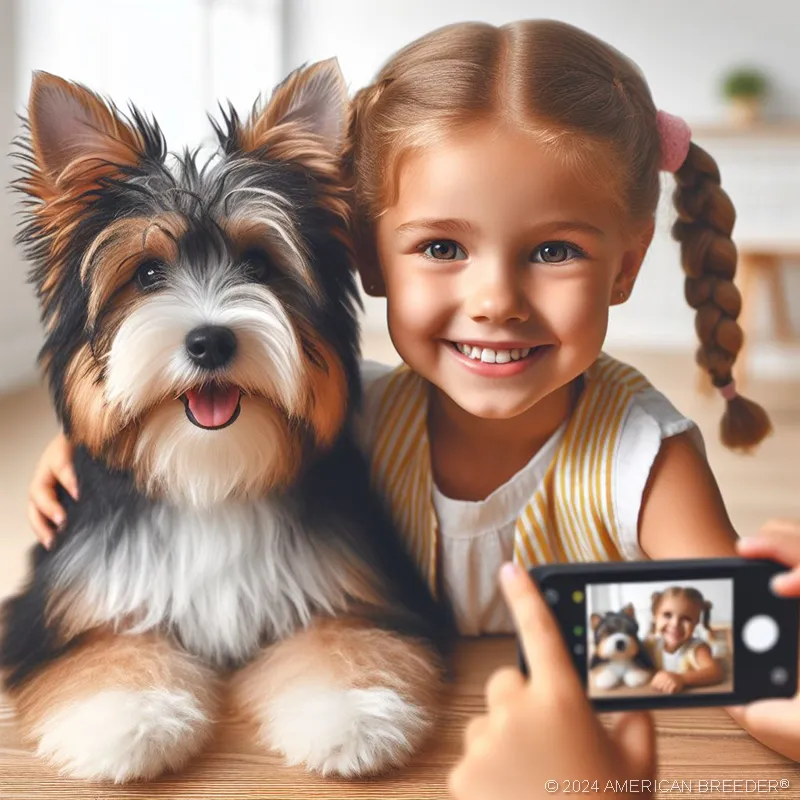 Setting a Routine for Effective Training
Setting a Routine for Effective Training
Establishing a regular training routine is essential for effective learning. Short, frequent training sessions are more beneficial than long, infrequent ones. A consistent schedule helps the Biewer Terrier retain information and maintain focus during training.
Tips to Keep Training Sessions Enjoyable and Productive
To keep training sessions enjoyable and productive, incorporate play and variety into the activities. Using toys, interactive games, and varying exercises can keep the Biewer Terrier engaged and eager to participate. Ensuring that training is a positive experience helps reinforce the dog’s enthusiasm for learning.
Basic Obedience Training and Commands
Essential Commands Every Dog Should Know
Basic obedience commands for the Biewer Terrier include “sit,” “stay,” “come,” and “down.” These commands are fundamental for ensuring the dog’s safety and facilitating effective communication. Teaching these commands early on provides a solid foundation for further training.
Importance of Regular Practice and Repetition
Regular practice and repetition are vital for reinforcing obedience commands. Consistent training helps the Biewer Terrier remember commands and respond reliably. Repetition also helps the dog become more comfortable and confident in its abilities.
Introducing Hand Signals Alongside Verbal Commands
Incorporating hand signals alongside verbal commands can enhance communication with the Biewer Terrier. Dogs often respond well to visual cues, and using hand signals can provide additional clarity and reinforce learning. Consistency in hand signals and verbal commands is important for effective training.
Importance of Voice Tone and Body Language in Training
Voice tone and body language play a significant role in training the Biewer Terrier. Using a calm and encouraging tone helps the dog understand commands and build trust. Positive body language, such as kneeling or maintaining eye contact, reinforces the connection between the owner and the dog.
Advanced and Specialized Training
Specialized Activities Suited for the Biewer Terrier
The Biewer Terrier excels in specialized activities that challenge its intelligence and agility. Agility training, obedience competitions, and interactive games are well-suited to this breed’s capabilities. Engaging in these activities provides mental and physical stimulation for the dog.
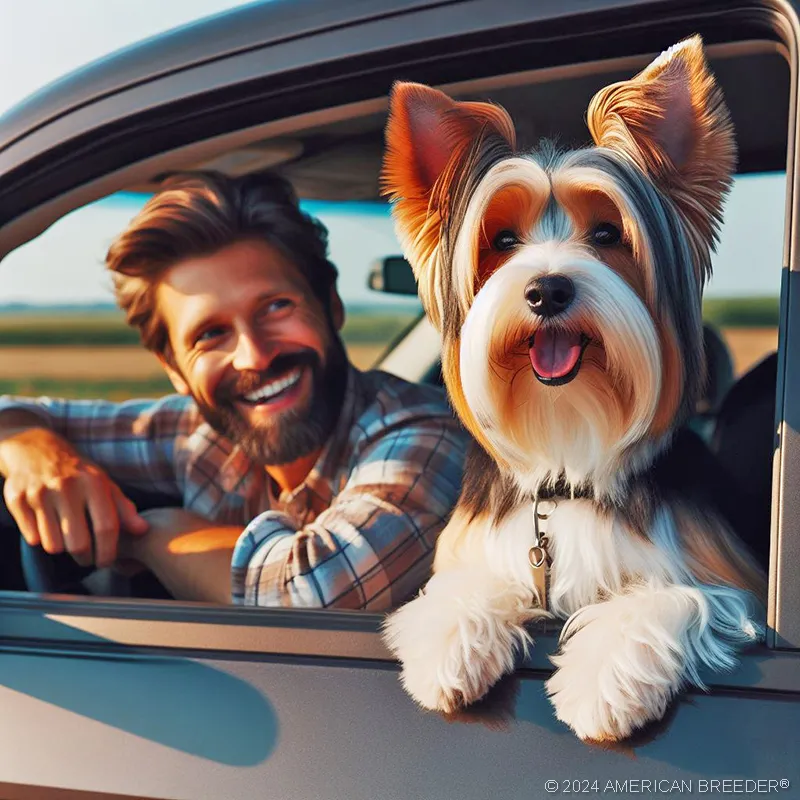 Training Requirements for Advanced Tricks and Behaviors
Training Requirements for Advanced Tricks and Behaviors
Training for advanced tricks and behaviors requires patience and consistent practice. Breaking down complex tasks into smaller steps and using positive reinforcement helps the Biewer Terrier master advanced skills. Regular practice and gradual progression ensure successful learning.
Introducing Props or Obstacles for Enhanced Training Sessions
Introducing props or obstacles during training can enhance the Biewer Terrier’s skills and engagement. Using agility equipment, puzzle toys, or interactive games provides additional stimulation and helps the dog develop problem-solving abilities. These elements add variety and interest to training sessions.
Behavioral and House Training
Behavioral Challenges or Specific Training Considerations for the Biewer Terrier
Behavioral challenges for the Biewer Terrier may include separation anxiety or excessive barking. Addressing these issues involves understanding the dog’s needs and providing appropriate training and socialization. Ensuring that the dog has ample stimulation and comfort can help mitigate behavioral problems.
House Training and Potty Training Tips
House training for the Biewer Terrier involves establishing a consistent routine and providing positive reinforcement for successful potty breaks. Using a designated potty area and monitoring the dog’s behavior can aid in effective house training. Patience and consistency are key to successful potty training.
Leash Training and Walking Etiquette
Leash training is essential for teaching the Biewer Terrier proper walking behavior. Using a well-fitted harness and practicing loose-leash walking helps the dog learn good walking etiquette. Positive reinforcement for walking calmly on a leash encourages desirable behavior.
Tips for Reducing Marking Behaviors Inside the House
To reduce marking behaviors inside the house, ensure that the Biewer Terrier is adequately house trained and has regular access to outside potty areas. Providing appropriate outlets for the dog’s energy and using enzymatic cleaners to remove any scent markers can help address marking issues.
Training for Specialized Roles and Jobs
Breed-Specific Roles for Therapy and Service Dogs
The Biewer Terrier can be trained for therapy and emotional support roles, leveraging its affectionate and gentle nature. Its small size makes it well-suited for providing comfort and companionship in various settings. Training for these roles involves teaching specific tasks and behaviors that support individuals with different needs.
Training Requirements for Working and Assistance Roles
Training for working and assistance roles requires a high level of focus and specialized skills. The Biewer Terrier must undergo thorough training to perform tasks effectively and provide the necessary support. This training includes learning specific commands and behaviors tailored to the role it will fulfill.
Certification and Qualifications for Therapy and Service Dogs
Certification for therapy and service dogs involves meeting specific training and behavioral standards. The Biewer Terrier must demonstrate proficiency in required tasks and exhibit a calm and reliable demeanor. Certification organizations evaluate the dog’s skills and suitability for its designated role.
Success Stories of Dogs Excelling in Specialized Roles
There are numerous success stories of Biewer Terriers excelling in specialized roles, such as therapy dogs providing emotional support to individuals in need. These stories highlight the breed’s ability to make a positive impact and demonstrate its potential in various roles beyond companionship.
Impact and Benefits of Service Dogs for Individuals with Disabilities
Service dogs, including those trained from the Biewer Terrier breed, provide invaluable assistance and support to individuals with disabilities. They offer companionship, perform specific tasks, and enhance the quality of life for their handlers. The presence of a service dog can greatly improve independence and overall well-being.
The Difference Between Service Dogs, Emotional Support Dogs, and Therapy Dogs
Service dogs are trained to perform specific tasks for individuals with disabilities, while emotional support dogs provide comfort and companionship without specialized training. Therapy dogs are trained to offer support in various settings, such as hospitals or nursing homes, and work under the guidance of a professional. Each type of dog plays a distinct role in supporting individuals and enhancing their quality of life.
Continuous Learning and Adaptation
Adapting Training Techniques as Your Dog Ages
As the Biewer Terrier ages, its training needs and abilities may change. Adapting training techniques to accommodate the dog’s age, energy levels, and physical condition is important for continued success. Regular adjustments to training methods ensure that the dog remains engaged and responsive.
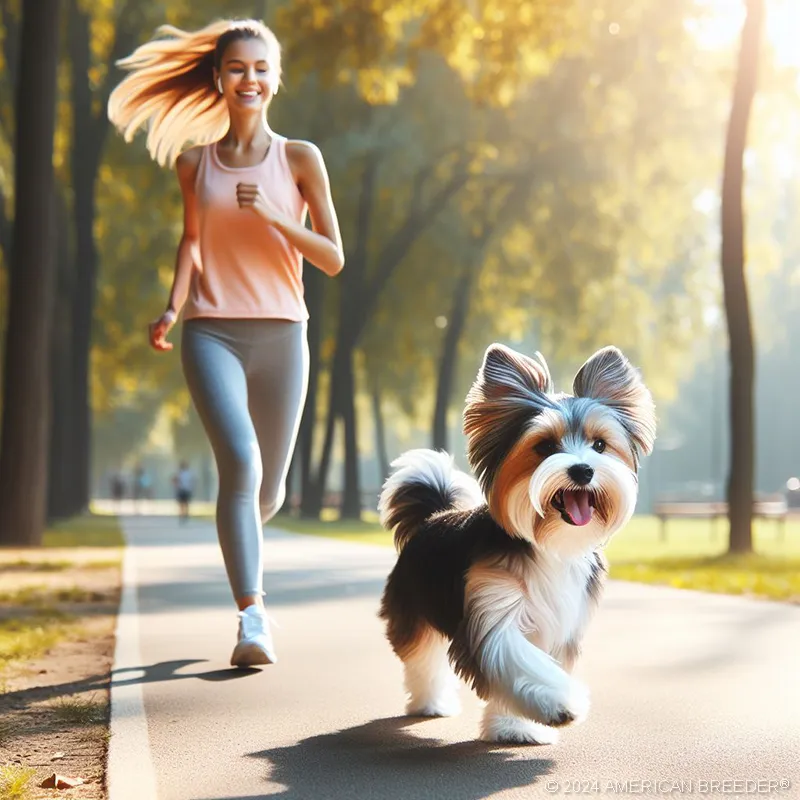 Overcoming New Behavioral Challenges
Overcoming New Behavioral Challenges
New behavioral challenges may arise as the Biewer Terrier matures or encounters different situations. Addressing these challenges involves understanding the root causes and applying appropriate training techniques. Seeking professional guidance if needed can help resolve persistent issues effectively.
Puppy Training
Understanding Puppy Behavior and Developmental Stages
Understanding puppy behavior and developmental stages is crucial for effective training. Puppies go through various phases of growth, including socialization, teething, and learning to control their impulses. Tailoring training approaches to these stages helps facilitate positive development and learning.
Socialization: Importance and Techniques
Socialization is critical for the Biewer Terrier puppy to develop into a well-adjusted adult dog. Introducing the puppy to different people, animals, and environments helps build confidence and adaptability. Positive experiences during socialization contribute to a balanced and friendly temperament.
Bite Inhibition Training
Bite inhibition training teaches puppies to control the force of their bite, which is essential for preventing aggressive behavior. Using gentle corrections and providing appropriate chew toys helps the Biewer Terrier puppy learn to manage its biting behavior.
Crate Training Benefits and Methods
Crate training offers numerous benefits, including providing a safe space for the puppy and aiding in house training. Introducing the crate gradually and using positive reinforcement helps the Biewer Terrier puppy become comfortable and see the crate as a positive environment.
The Role of Teething and How to Manage It
Teething can be a challenging phase for puppies, including the Biewer Terrier. Providing appropriate chew toys and managing teething discomfort with cold items or teething gels can help alleviate the puppy’s discomfort and prevent destructive chewing behavior.
Importance of Short, Frequent Training Sessions for Puppies
Short, frequent training sessions are more effective for puppies than long, infrequent ones. Puppies have limited attention spans, and brief training sessions help maintain their focus and enthusiasm. Regular practice in short bursts ensures that the Biewer Terrier puppy remains engaged and eager to learn.
Social Behavior and Interaction Training
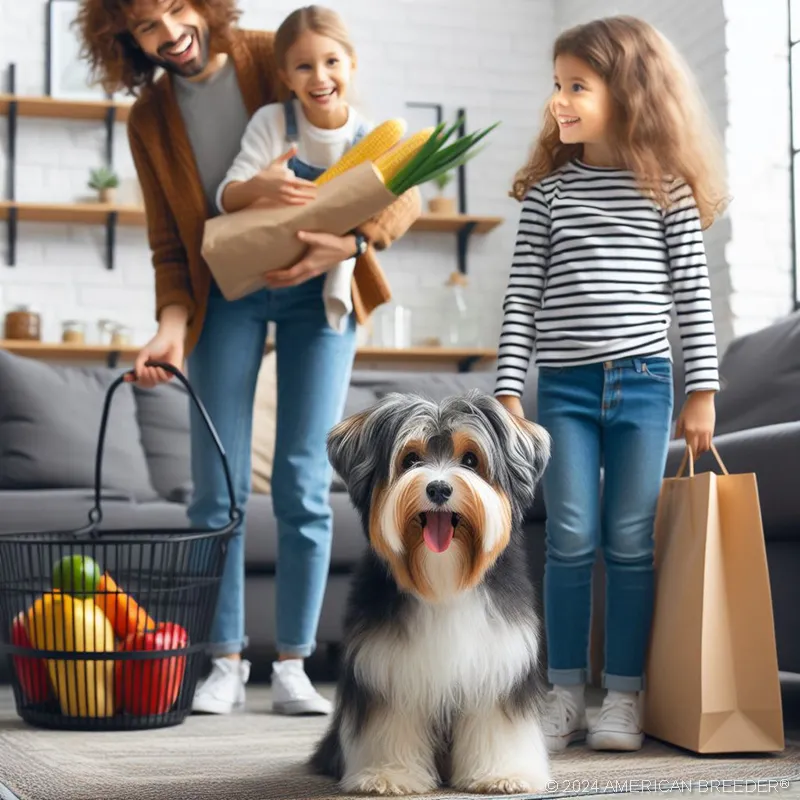 Introducing Your Dog to Other Dogs and Pets
Introducing Your Dog to Other Dogs and Pets
Introducing the Biewer Terrier to other dogs and pets should be done gradually and in a controlled environment. Positive interactions and supervised introductions help the dog develop good social skills and reduce the likelihood of conflicts or anxiety.
Human Interaction: Kids, Strangers, and Guests
The Biewer Terrier’s friendly nature makes it well-suited for interacting with children, strangers, and guests. Ensuring positive experiences during these interactions helps the dog develop good manners and social behavior. Proper supervision and training reinforce desirable behavior.
Addressing Aggressive or Timid Behavior
Addressing aggressive or timid behavior involves understanding the underlying causes and applying appropriate training techniques. For aggressive behavior, desensitization and counter-conditioning can help modify responses. For timid behavior, positive reinforcement and gradual exposure can build confidence.
Techniques for Desensitizing Dogs to Various Stimuli
Desensitizing the Biewer Terrier to various stimuli involves gradual exposure and positive reinforcement. Introducing new sounds, sights, and experiences in a controlled manner helps the dog become accustomed to different stimuli without fear or anxiety.
Stimulating Activities and Enrichment
Importance of Mental Stimulation for Dogs
Mental stimulation is crucial for the Biewer Terrier’s well-being. Engaging the dog in activities that challenge its intellect and problem-solving skills helps prevent boredom and promotes overall happiness. Puzzle toys, training exercises, and interactive games provide valuable mental enrichment.
Training with Toys, Puzzles, and Interactive Games
Using toys, puzzles, and interactive games enhances the Biewer Terrier’s training experience. These activities provide mental stimulation and can be incorporated into training sessions to keep the dog engaged and motivated. Interactive games also offer a fun way to bond with the dog.
Agility and Sports Training for the Biewer Terrier
Agility and sports training are excellent ways to channel the Biewer Terrier’s energy and intelligence. The breed’s small size and agility make it well-suited for agility courses and other canine sports. Participating in these activities provides physical exercise and strengthens the bond between the dog and its owner.
Introducing Nose Work and Scent Games
Nose work and scent games are effective for stimulating the Biewer Terrier’s natural instincts and providing mental enrichment. Training the dog to use its sense of smell to find hidden treats or objects can be both enjoyable and rewarding. These activities offer a fun way to engage the dog’s mind and senses.
Handling Common Behavioral Issues
Addressing Excessive Barking or Whining
Excessive barking or whining in the Biewer Terrier can be managed through proper training and environmental adjustments. Identifying the triggers for barking or whining and addressing them with positive reinforcement and distraction techniques helps reduce unwanted behaviors.
Managing Separation Anxiety in Dogs
Managing separation anxiety in the Biewer Terrier involves gradual desensitization and providing comfort items. Creating a positive and secure environment when leaving and returning home helps the dog feel more at ease. Consulting with a professional trainer may be necessary for severe cases.
Counteracting Destructive Behaviors like Digging and Chewing
Destructive behaviors such as digging and chewing can be counteracted by providing appropriate outlets for the Biewer Terrier’s energy. Engaging the dog in regular exercise and offering chew toys can help prevent these behaviors. Supervision and redirection are also important in managing destructive tendencies.
Reducing Jumping on People
Reducing jumping behavior involves teaching the Biewer Terrier alternative behaviors and reinforcing calm greetings. Using positive reinforcement for sitting or staying when greeting people helps discourage jumping. Consistent training and clear communication are key to addressing this issue.
Tackling Food Aggression or Resource Guarding
Food aggression or resource guarding can be managed through desensitization and counter-conditioning techniques. Teaching the Biewer Terrier to associate positive experiences with the presence of food or resources helps reduce guarding behaviors. Gradual training and positive reinforcement are essential in addressing these issues.
Health and Wellness Considerations in Training
Recognizing and Adjusting to Physical Limitations (age, health issues)
Recognizing and adjusting to the Biewer Terrier’s physical limitations is important for effective training. Older dogs or those with health issues may require modified training techniques and exercises. Consulting with a veterinarian and adapting training approaches to the dog’s condition ensures its well-being.
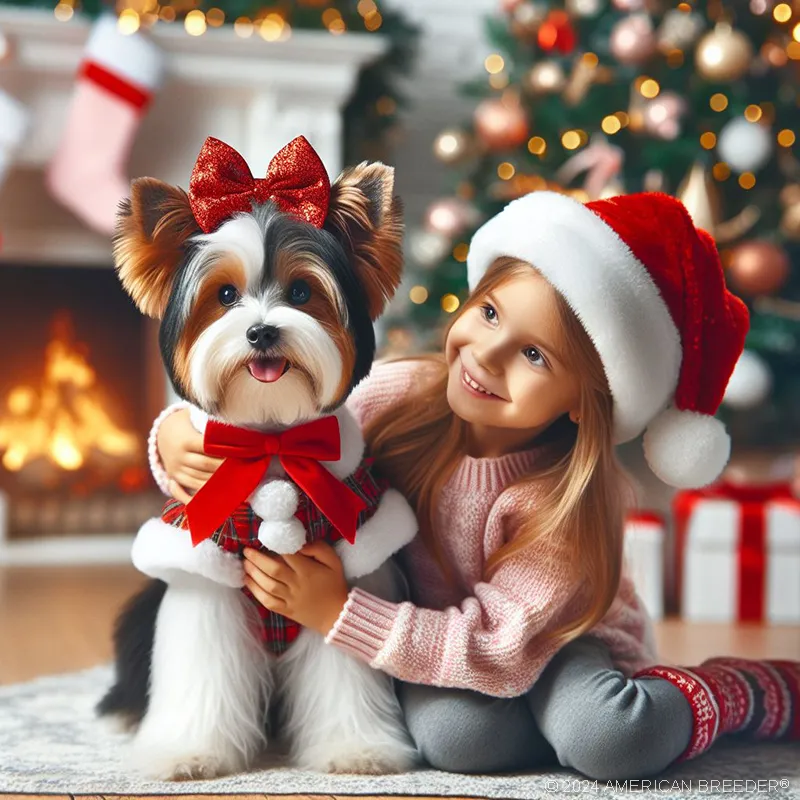 Diet and Nutrition's Impact on Training
Diet and Nutrition's Impact on Training
Diet and nutrition play a significant role in the Biewer Terrier’s training and overall health. Providing a balanced and nutritious diet supports the dog’s physical and mental well-being. Proper nutrition enhances the dog’s energy levels and responsiveness during training.
The Role of Exercise in Training and Behavior
Exercise is crucial for the Biewer Terrier’s training and behavior. Regular physical activity helps manage energy levels, reduces behavioral issues, and promotes overall health. Incorporating exercise into the dog’s daily routine supports successful training and positive behavior.
Recognizing Signs of Overexertion or Stress During Training
Recognizing signs of overexertion or stress during training is important for the Biewer Terrier’s well-being. Symptoms such as excessive panting, lethargy, or reluctance to participate indicate that the dog may need a break or adjustment in training intensity. Monitoring the dog’s condition helps prevent overexertion and ensures a positive training experience.
The Importance of Regular Vet Check-ups and Their Impact on Training
Regular veterinary check-ups are essential for maintaining the Biewer Terrier’s health and supporting effective training. Routine exams help identify and address any health issues that may impact the dog’s training and behavior. Ensuring that the dog is in good health contributes to successful training outcomes.
Emergency and Safety Training
Training Dogs to Respond in Emergencies (fire, earthquakes)
Training the Biewer Terrier to respond to emergencies involves teaching basic safety behaviors and ensuring that the dog is accustomed to emergency situations. Desensitization to loud noises and practicing recall commands can help the dog respond effectively in emergencies.
Recall Training: Ensuring Your Dog Comes When Called
Recall training is crucial for ensuring the Biewer Terrier comes when called, especially in emergency situations. Using positive reinforcement and practicing recall commands in various environments helps the dog respond reliably. Consistent training and clear communication are key to successful recall.
Boundary and Off-Leash Training
Boundary and off-leash training help the Biewer Terrier understand its limits and navigate safely without a leash. Teaching the dog to stay within designated areas and respond to commands off-leash enhances its safety and freedom. Gradual training and supervision are important for effective boundary training.
Training Dogs to Safely Navigate Stairs, Elevators, and Other Common Hazards
Training the Biewer Terrier to safely navigate stairs, elevators, and other common hazards involves gradual exposure and positive reinforcement. Ensuring that the dog is comfortable and confident in these situations helps prevent accidents and promotes safe behavior.
Safe Transportation and Car Behavior Training
Safe transportation and car behavior training are essential for the Biewer Terrier’s well-being during travel. Teaching the dog to remain calm and secure in the car, using appropriate restraints, and practicing car rides help ensure a safe and comfortable experience. Regular training and gradual exposure to car travel are beneficial.
Technology and Dog Training
 Using Apps and Online Platforms for Training Support
Using Apps and Online Platforms for Training Support
Apps and online platforms offer valuable support for dog training, including tools for tracking progress and accessing training resources. Utilizing these technologies can enhance the Biewer Terrier’s training experience and provide additional guidance for owners.
Modern Tools and Gadgets for Effective Training
Modern tools and gadgets, such as clickers and treat dispensers, can aid in effective training for the Biewer Terrier. These tools facilitate communication and reinforcement, making training sessions more efficient and engaging.
Monitoring Progress with Wearable Tech
Wearable technology, such as fitness trackers, can help monitor the Biewer Terrier’s progress and health during training. Tracking activity levels and training metrics provides valuable insights into the dog’s development and overall well-being.
Benefits and Drawbacks of Using Electronic Training Aids (e.g., shock collars)
Electronic training aids, such as shock collars, have both benefits and drawbacks. While they can be effective in some situations, they should be used with caution and under professional guidance. Positive reinforcement methods are generally preferred for training the Biewer Terrier, as they promote a positive and trusting relationship.
Continuous Education for Dog Owners
Staying Updated with Latest Training Methods and Research
Staying updated with the latest training methods and research is important for effective dog training. Continuing education helps owners incorporate new techniques and approaches, ensuring that their training practices are current and effective.
Joining Dog Training Groups and Workshops
Joining dog training groups and workshops provides opportunities for owners to learn from experts and share experiences with other dog owners. Participating in these groups enhances knowledge and skills, contributing to successful training outcomes.
Understanding the Importance of Persistence and Patience
Persistence and patience are crucial in dog training. Understanding that training is a gradual process and being patient with the Biewer Terrier’s progress helps achieve desired results. Consistent effort and a positive attitude contribute to successful training experiences.
Reading Resources and Books on Dog Behavior and Training
Reading resources and books on dog behavior and training provides valuable insights and techniques for effective training. Exploring various materials helps owners deepen their understanding of canine behavior and improve their training practices.
Practical Considerations
Size of Sleeping Quarters Depending on Size
The Biewer Terrier’s small size means it requires a relatively compact sleeping area. Providing a cozy and comfortable bed that fits the dog’s size ensures a restful and secure sleeping environment.
Typical Annual Veterinary Cost
The typical annual veterinary cost for a Biewer Terrier includes routine check-ups, vaccinations, and preventive care. Costs can vary based on location and the dog’s specific health needs. Budgeting for these expenses helps ensure the dog’s health and well-being.
Type of Grooming and Annual Cost
The Biewer Terrier’s grooming needs include regular brushing, occasional baths, and nail trimming. Annual grooming costs can vary based on the frequency of professional grooming services and the dog’s coat condition.
Investing in grooming tools and services helps maintain the breed’s elegant appearance.
Daily Exercise Needs and Requirements
The Biewer Terrier requires daily exercise to maintain its health and happiness. Regular playtime, short walks, and interactive activities help meet the dog’s exercise needs. Ensuring adequate physical activity supports overall well-being.
Level of Playfulness
The Biewer Terrier is known for its high level of playfulness. It enjoys engaging in games and interactive activities with its owner. Providing opportunities for play and mental stimulation enhances the dog’s happiness and strengthens the bond between owner and pet.
Exercise Requirements and Physical Activity
Specific Exercise Needs Based on Age and Energy Level
The Biewer Terrier, though diminutive in stature, boasts a high level of energy that varies with age and activity level. Puppies are particularly exuberant and require frequent, short bursts of play to help manage their boundless energy. These activities support their physical development and mental growth. As they mature into adults, their energy needs stabilize but remain substantial. Regular exercise, including walks and interactive play, helps to maintain their overall health and behavioral balance.
Senior Biewer Terriers, while still active, often exhibit a decrease in energy and stamina. Gentle exercise routines, such as leisurely walks and light play, are recommended to keep them fit without straining their aging joints and muscles. Adjusting the intensity and duration of their activities can help accommodate their evolving physical capabilities.
Recommended Daily Exercise Routines and Duration
For a well-rounded exercise regimen, Biewer Terriers should engage in at least 30 to 60 minutes of physical activity daily. This can be segmented into multiple short sessions to match their energy levels and maintain engagement. A typical routine might include a morning walk of 15 to 20 minutes, interactive play sessions throughout the day, and an evening walk or playtime to wind down. These activities ensure that the dog remains physically fit and mentally stimulated.
Incorporating variety into their exercise routine—such as agility drills, fetch, or obedience training—can keep the Biewer Terrier entertained and motivated. This variety also helps prevent boredom and associated behavioral issues.
Exercise Alternatives for Inclement Weather or Limited Outdoor Space
When outdoor conditions are unfavorable or space is limited, indoor exercise alternatives are essential. Indoor play can include using interactive toys, puzzle feeders, and engaging in games like hide-and-seek. Creating a small agility course with household items can also be an effective way to provide physical and mental stimulation.
Additionally, a dog treadmill can be a useful tool for maintaining physical fitness when outdoor exercise is not possible. Regular indoor play and mental enrichment activities ensure that the Biewer Terrier remains active and engaged, regardless of external conditions.
Mental Enrichment Activities and Games to Keep the Breed Stimulated
Mental stimulation is crucial for the Biewer Terrier, as it complements their physical exercise and helps prevent boredom. Activities that challenge their problem-solving skills, such as treat-dispensing toys, interactive puzzles, and scent games, are highly beneficial. Training sessions that introduce new commands or tricks also serve as effective mental stimulation.
Engaging the dog in varied and enriching activities can help maintain their mental sharpness and overall well-being. Rotating toys and incorporating new games can keep their environment interesting and dynamic.
Exercise Safety Considerations and Precautions
Ensuring the safety of the Biewer Terrier during exercise involves several precautions. Always supervise the dog during physical activities to prevent injuries. For outdoor exercise, check the environment for hazards like sharp objects or toxic plants.
In extreme weather conditions, such as heat or cold, take appropriate measures to protect the dog. Provide access to fresh water and shade during hot weather and ensure adequate warmth and protection during cold spells. Gradually increase the intensity of exercise to prevent overexertion and monitor the dog’s response to avoid injury.
Financial Planning
Typical Price Range for Purchasing Biewer Terrier from Reputable Breeders
The cost of purchasing a Biewer Terrier from reputable breeders typically ranges between $2,500 and $5,000. This price range reflects the breeder’s commitment to maintaining high standards in health, genetics, and overall breed quality. Prospective owners should expect to pay a premium for dogs from well-regarded breeders who provide proper documentation and health clearances.
Initial Costs
Initial costs for acquiring a Biewer Terrier extend beyond the purchase price. These include adoption or purchase fees, which cover the dog’s initial health check, vaccinations, spaying or neutering, and microchipping. This can amount to an additional $300 to $600. Initial setup costs such as bedding, food, and basic grooming supplies should also be considered.
Ongoing Expenses
Ongoing expenses for a Biewer Terrier encompass food, grooming, veterinary care, training, and supplies. Monthly food costs are generally around $30 to $50, depending on the quality of the dog food. Regular grooming, whether done at home or by a professional, might cost $50 to $100 per session. Veterinary care, including annual check-ups, vaccinations, and unexpected medical issues, can vary widely but should be budgeted at $300 to $600 annually. Training and toys add to the ongoing costs, with an estimated $200 to $500 per year for various training classes and interactive toys.
Considerations for Pet Insurance or Budgeting for Unexpected Medical Costs
Pet insurance is a valuable consideration for managing unexpected medical expenses. Monthly premiums for a Biewer Terrier typically range from $20 to $50, depending on the coverage and deductible chosen. Insurance can provide financial protection against unexpected health issues, helping to offset potentially high veterinary costs.
Budgeting for unexpected medical costs is also crucial. Setting aside a reserve fund of $500 to $1,000 can help cover emergency expenses that insurance might not fully address. This approach ensures that you are prepared for any unforeseen health issues that may arise.
Options for Pet Care During Vacations or Travel
When traveling or on vacation, arranging proper care for your Biewer Terrier is essential. Options include hiring a pet sitter, using a reputable boarding facility, or arranging for care with friends or family. Pet sitting services typically cost $15 to $30 per visit, while boarding facilities may charge $25 to $50 per night. Ensuring that the care provider is experienced and comfortable with the Biewer Terrier’s needs is crucial for the dog’s well-being while you are away.
Biewer Terrier Dog Quick Reference Guide
Breed Background: Origin: Germany | Breed Purpose: Companion | AKC Class: Toy | Year Recognized by AKC: 2021 Appearance: Size: Small | Weight: 4-8 lbs | Coat Type: Long, Silky | Colors & Patterns: Blue, White, Gold | Distinctive Features: Elegant, flowing coat; expressive eyes
Appearance: Size: Small | Weight: 4-8 lbs | Coat Type: Long, Silky | Colors & Patterns: Blue, White, Gold | Distinctive Features: Elegant, flowing coat; expressive eyes
Temperament: Energy Level: 3 | Loyalty: 5 | Friendliness to Pets: 4 | Friendliness to Strangers: 4 | Trainability: 4 | Playfulness: 5 | Frequent Barker: 3 | Chase Instincts: 2 | Sense of Smell: 2 | Drive to Hunt: 1
Health & Care: Health Issues: Dental problems, patellar luxation, hypoglycemia | Lifespan: 12-15 years | Grooming Difficulty: High | Exercise Needs: Moderate
Socialization: Interaction with Children: Generally good, though supervision is recommended | Interaction with Pets: Usually friendly, may be wary of larger dogs | Interaction with Strangers: Friendly but cautious | Elderly Compatibility: Suitable, enjoys calm companionship | Ease of Training: Moderate; responds well to positive reinforcement
Suitable Living Arrangements: Apartment: Yes | House: Yes | Rural Area: Yes | Yard Size Requirements: Small to medium
Training & Obedience: Trainability: 3 | Intelligence: 4 | Obedience: 4 | Problem-Solving: 3 | Easily Stimulated: 4 | Focus Level: 3 | Easily Distracted: 3
Financial Planning: Typical Price Range: $3,000 - $5,000 | Initial Expenses: Adoption/Purchase, vaccinations, spaying/neutering, microchipping | Ongoing Annual Expenses: Food, grooming, veterinary care, training, toys, and supplies
Breeding: Reproductive Maturity: 12-18 months | Litter Frequency: 1-2 times per year | Litter Size: 2-5 puppies | Stud Cost: $1,500 - $3,000 | Breeding Challenges: Coat care, potential for health issues
Did You Enjoy this Article? Share it and Help Us Spread the Word!
If you found this article helpful, we'd appreciate it if you could share it with your friends or link to it from your website, blog, or group! You can also use the convenient social share tabs on the left side of the screen to instantly share this page to your social media feed. For more ways to support and promote the American Breeder Community, visit our Share & Promote Together page for social media posts and memes you can copy and share. Your support means the world to us!
Disclaimer: The information provided in this article is for general informational purposes only and does not constitute legal, medical, financial, or professional advice. While we strive for accuracy, we make no representations or warranties regarding the completeness, accuracy, reliability, or suitability of the information. Please consult with a professional before making decisions based on the content provided. American Breeder Inc. assumes no responsibility for any errors or omissions or for the results obtained from the use of this information.
